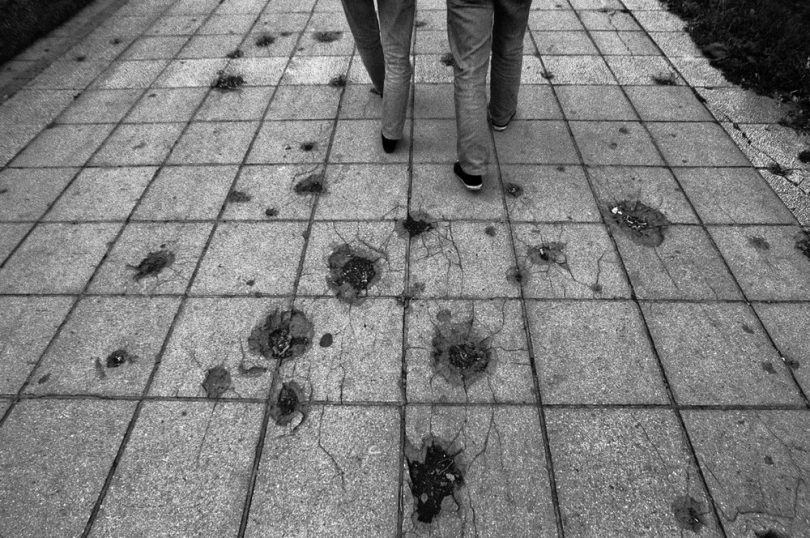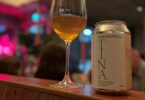On a warm night last June, my father was leaning against the cool railing of the balcony in a Sarajevo flat. Pointing at the rooftops of his old neighbourhood of Grbavica, he was retelling old stories. Painting pictures of sitting on rooftops with his friends, drinking, smoking and playing the guitar.
The light from inside the apartment was pooling at our feet and reflecting off the tiles. Light bounced around us and onto his face. The wisps of his grey hair caught the light. He seemed distant; eyes glazed over. It was as if a man with the same crooked nose and brown eyes, had been dealt a different fate. He seemed young and full of excitement. Something in my gut twisted.
I walked back into the apartment, toward the kitchen where my mother was sitting, eating a warm peach from the local summer market. She was still watching my father as I sat on the stool across from her. “He needs it more than you,” she said, watching him intently. “It’s like a sort of therapy.” My mother is an observant woman. Cunning and incredibly sharp. Her good humour seemed to fade in this city. Replaced with something more cautious. She carried tension in her shoulders and wary in her eyes.
Sarajevo was once a beautiful European city. Hidden by surrounding mountains and forests, the city is located in a valley, cradled by the Alps. It collided east and west in wonderful chaos, which resulted in a hybrid culture of contrast. On these ancient Sarajevo cobblestoned streets, art and craft had been born and raised. Traditions reawakened and reinvented.
You can imagine the ghosts of old professors and carpet weavers sitting with a plate of ćevapi and drink from their fildžan. Discussing politics in the old part of town, Baščaršija. Now it is a mass grave. The siege of Sarajevo lasted one thousand, four hundred and twenty-five days. It began in 1992 and lasted roughly three years and 10 months.
The siege drove unambitious decent men and women to their basest animalistic states. A city of predators and scavengers, feeding on each other when the food ran out. Snipers would target men, women and children alike, playing God through their crosshairs. My parents were 21 when war broke out. My age now.
This year marks 25 years since the massacre of Srebrenica. A slaughter that cost the lives of some 8,000 boys and men. The Netherlands International Law Review described it as the “worst massacres in Europe after the Second World War.” I didn’t know much about it. Slowly and carefully, my parents have been revealing little fragments of their experiences as war refugees from the former Yugoslavia. Frankly, I can’t tell whether they avoid the whole truth, or simply cannot remember it. Sometimes it felt like looking into broken mirror shards. Frustrated because the image is too broken to understand.
I’d hoped our trip to their old city would help me grasp a little of what hangs over them. To gain some understanding or clarity. I’d even settle for context. Walking through Sarajevo’s inner city, it is hard to ignore craters and bullet holes that litter the surrounding buildings. Shards of glass lay next to shattered windows. The everyday Sarajlija simply extend their steps to avoid it.
On the side of busy streets, women sit with children in their laps, hands extended out. Day after day. Sometimes they approach tourists with little cloudy photographs of family members they’d lost. Hands cupped for coins. In 2018, an estimated 18.56 per cent of Bosnia and Herzegovina residents live in poverty. We are warned of the packs of wild dogs that stalk the streets. Consequences of the pedigree breeds forced into survival during the war. Weeds climb the rusted playgrounds of parks which are left to overgrow.
The river ‘Miljacka’ runs throughout the city, murky and dull. Locals tell us that during the war, the river was clear and home to jumping fish. Little silver scales of the Sapača catching the sunlight. Not to be seen since. There is a peace, watching the river run in all its murky glory. An ironic thought considering its violent history of the Franz Ferdinand assassination and the Balkan war.
To the north of the river lies Sarajevo’s jewel; Baščaršija. This remnant of the Ottoman era decorates Sarajevo. Walking these streets, you could almost forget the cities trauma until you meet a vendor selling souvenirs made of bullet shells. Little copper soldiers lining his old wood table. I remember looking back at my father and mother, trying to gauge their reaction. Nothing. It felt wrong to me. Profiting and making a novelty out of something that has hurt the people I love.
We’d continue our travel quietly. My mother was silent as we travelled. Her mouth a thin line as she walked with an unusual stiffness. My father would stop and point things out to her. He’d shake his head at the things changed and unchanged. Pointing his small camera toward the old apartment buildings and derelict streets. It struck me that the city had never rebuilt. In true Bosnian fashion, it had simply moved on.
Once I had asked my mother if she was angry. The question seemed unbelievably silly. Her youth was stolen, given a soundtrack of snipers, rockets and bombs. She’d lost her 22-year-old cousin, Sanja, in 1992. A grenade dropped into their courtyard, murdering her and three children. Her brother, Igor, died the age of 18 years old. He was buried under a false name for years. She pondered for a moment before she replied. “Who would I be angry at?” she replied. “After a while, you realise that every side experienced the very same thing. I shake every time I speak about the war, but it made me the person I am today.”
It’s true. I had never seen my mother display any anger toward what she had experienced. As we walked the streets of Sarajevo, she seems to carry a disappointment in her shoulders. I used to believe it was directed at the memories of this city. Perhaps it is, but now I suspect it is the feeling of being foreign in your own hometown. It would be cruel heartbreak to walk in a city that once made it clear you were not welcome.
I wonder if on that warm Sarajevo summer night, as my father overlooked the rooftops of Grbavica, he could hear the faint melody of his youth. Eyes so focused on the cracked concrete; I swear he could smell the cigarette smoke wafting to the beat of a strumming guitar—two existences watching one another, decades apart.
(Featured Image: Bullet holes in the pavement, taken between 1992-1995 during the siege of Sarajevo. DEJAN VEKIC )




